Airfix 1/72 Sunderland I
|
KIT #: |
6001 |
|
PRICE: |
$ |
|
DECALS: |
One option |
|
REVIEWER: |
Carmel J.
Attard |
|
NOTES: |
Pavla resin sets C72-115, U72-142, U72-143 |

The Sunderland flying boat was the RAF’s longest serving operational aircraft.
It was first delivered to No 230 Squadron in Singapore back in June 1938. First
flown on 16th October 1937 and was powered by 790hp Pegasus X
engines. It entered production with Pegasus XXII and a revised nose and tail
armament. By 3rd September 1939 forty were in service with four RAF
squadrons. Ninety Mk1s were eventually completed including fifteen built by
Blackburn.
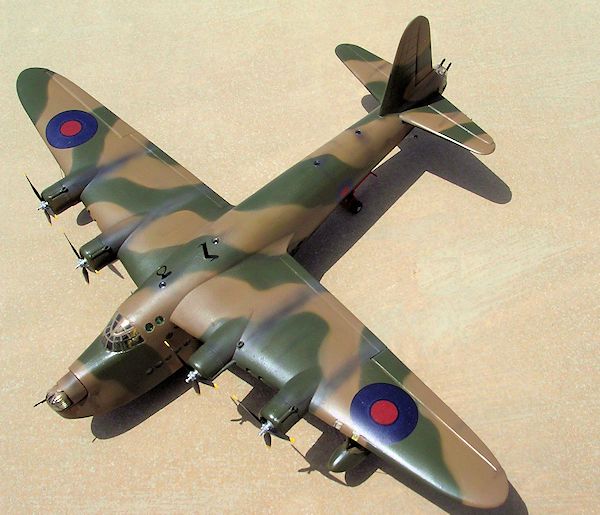 At the end of 1941 the Sunderland Mk II began to replace the Mk I. These
were powered by Pegasus XVIII engines; with two stage superchargers; a twin gun
Botha-type dorsal turret in place of the ‘midship gun ports; an improved
tail-turret and ASV radar. Rising operating weights now necessitated redesign of
the hull planning bottom, and the Mk II on which this was tested thus became the
prototype for the chief production model, the Sunderland Mk III. The first Short
built Mk III flew on 15th December 1942 and 286 were produced and a
further 170 built by Blackburn.
At the end of 1941 the Sunderland Mk II began to replace the Mk I. These
were powered by Pegasus XVIII engines; with two stage superchargers; a twin gun
Botha-type dorsal turret in place of the ‘midship gun ports; an improved
tail-turret and ASV radar. Rising operating weights now necessitated redesign of
the hull planning bottom, and the Mk II on which this was tested thus became the
prototype for the chief production model, the Sunderland Mk III. The first Short
built Mk III flew on 15th December 1942 and 286 were produced and a
further 170 built by Blackburn.
Mediterranean theatre of operations.
The roles of islands of Gibraltar and Malta were critical to allied
strategy and survival in this theatre during the war. Two aircraft left Pembroke
Dock for Malta on the 29th of April 1940. The outbreak of war saw
three Sunderlands at Malta and four more aircraft moved to Malta on the 9th
of September. The following day four Sunderlands flew back to Pembroke Dock.
With the outbreak of war Sunderland flying boats based in Malta achieved
a number of successes against axis shipping and submarines and keeping a watch
on movement of the Italian fleet. While performing these missions Sunderlands
were also frequently jumped by Italian CR-42s and Macchis, often shooting down
the intruders for the cost of injured crews and damage to the aircraft.
Mediterranean Sunderland units were involved in first major battles
between the Royal Navy and the Italian fleet. In one such incident taking place
during the day, Flight Lieutenant Woodward of 230 Squadron attacked and claimed
a hit on an Italian Submarine (probably Zoea), while Squadron Leader Menzies was
fired on by anti aircraft and engaged in a 30 minute running fight with an
He-115, which eventually broke off. Three days later Menzies attacked and
claimed to have sunk an unidentified Italian submarine (probably Settimo).
Sunderlands did not always have things all their own way. On 25th
July a Sunderland, flown by Flt. Garside was attacked by three Fiat CR-42s. The
crew shot down one of the biplanes and scored hits on another. The aircraft
itself was heavily damaged and just struggled back to Malta. On 28th
July another aircraft was bounced by three Macchi 200. Its crew claims to have
shot down one and forced another to break because of damage. Sqd Leader Riley
was less lucky with three gunners being wounded during an hour-long engagement
with four Macchis. The Sunderland struggled back to Malta where it was beached
to avoid sinking.
On 17th September a Sunderland flown by Sq Leader Menzis
turned aggressor when its crew claims met a Cant Z-501 flying boat and shot it
down in flames. 230 Squadron Sunderland continued to monitor the Italian fleet.
Skirmishes and tales told by crew continued
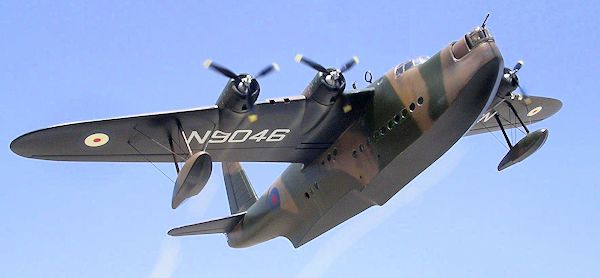 throughout the war also while
protecting convoys on their way to Malta.
throughout the war also while
protecting convoys on their way to Malta.
Incidents also involved Sunderlands being directly attacked at their
bases in Malta. During March and early April 1941 four Sunderlands were strafed
at their moorings at Kalafrana base and at St Paul’s Bay. Two of the flying
boats being destroyed by Oberleutenant Jouchim Munchenburg. One such victim of
an air raid on Kalafrana was a 228 Squadron Sunderland L5807 which caught
fiercely after such attack.
This all happened when on the 7th of March Sunderland L2149 of
228 Sq was attacked at its Kalafrana moorings by two Bf109s. Sgt Jones acted as
boat guards and managed to get his Vickers gun into action before being fatally
hit. The Sunderland was badly damaged but it was in trouble again later during
another similar attack. Sunderland L2164 was damaged and T9046 caught fire. A
party boarded the latter aircraft, which apparently got the fire under control
but after an interval blazed up again. The aircraft was taxied and beached but
had to be abandoned and ultimately sunk.
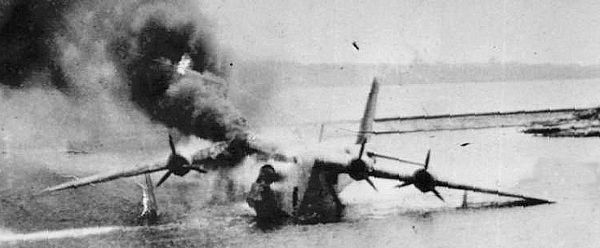 L2164 was flown to St Paul’s Bay
and moored at the Mistra inlet of the bay. On the 10th of March it
was attacked and set alight by two Bf109s from 7/JG26. The Sunderland has been
rendered immobile during the strafing attack by the Messerschmitt that belonged
to the same Staffel, 72 hours earlier. The aircraft sank when efforts were made
to tow it ashore. In 1964 myself and RAF flt sergeant Elliott dived at the same
location at Mistra sea and at around 18 feet of depth recovered a piece of
Sunderland hull; which we sent to Short brothers in Ireland who confirmed that
it came from a Sunderland but said had no other records. They also sent us
drawings of the retrieved part that confirmed it came from part of the hull.
L2164 was flown to St Paul’s Bay
and moored at the Mistra inlet of the bay. On the 10th of March it
was attacked and set alight by two Bf109s from 7/JG26. The Sunderland has been
rendered immobile during the strafing attack by the Messerschmitt that belonged
to the same Staffel, 72 hours earlier. The aircraft sank when efforts were made
to tow it ashore. In 1964 myself and RAF flt sergeant Elliott dived at the same
location at Mistra sea and at around 18 feet of depth recovered a piece of
Sunderland hull; which we sent to Short brothers in Ireland who confirmed that
it came from a Sunderland but said had no other records. They also sent us
drawings of the retrieved part that confirmed it came from part of the hull.
Injection
molded in thick white plastic with heavy rivet detail all over the surfaces of
kit parts, a hallmark of Airfix early kits. It is a big size model and contains
around 152 kit parts. These include beaching gear parts as well as all the clear
parts. There are bomb racks
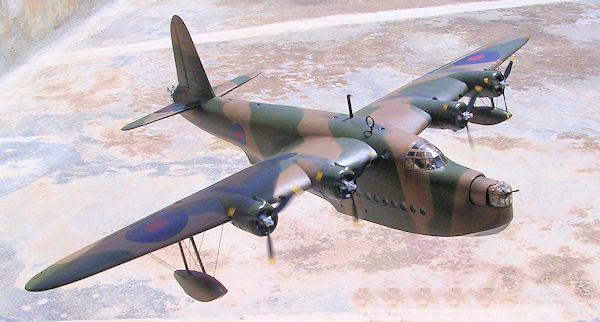 for 4 bombs that slide from inside the fuselage
under the wing root. Crew figures are included for the cockpit office, which is
sparsely represented, and for the three rotating turrets. Stage-by-stage
illustrated instructions make it an easy build in spite of its size. Decal sheet
for one camouflaged Sunderland Mk III in temperate maritime scheme is supplied.
for 4 bombs that slide from inside the fuselage
under the wing root. Crew figures are included for the cockpit office, which is
sparsely represented, and for the three rotating turrets. Stage-by-stage
illustrated instructions make it an easy build in spite of its size. Decal sheet
for one camouflaged Sunderland Mk III in temperate maritime scheme is supplied.
Conversion
of the Mk III into a Mk1.
Conversion incorporates three basic tasks all of which are visible on the
outside. New engine cowlings, propellers, new cockpit canopy and full interior
are supplied by Pavla Models who make sets for enhancement of the new kit recent
release by Italeri.
(You can see reviews of all these bits in the
archives. Ed)Then there is removal of the upper turret, which is blanked,
and depending which particular mark that one makes may add upper side open
turrets, and also an additional fuselage side window. There is also alteration
to the staggered hull area. The thickness of kit plastic may allow the reshaping
of this are.
All the oversize rivet detail is first sanded down to a smooth surface.
The first stage is to assemble and paint the detailed upper crew deck C72-115
that contains floor, crew seats, detailed bulkheads instruments attached to side
consoles, which when painted and fitted in place of kit parts will be complete
with a clear vac form canopy that comes in same set. An additional round
porthole is added at the fuselage centre making a set of three in place of
existing two. The extra window added at the rear with same spacing and size as
the previous two.
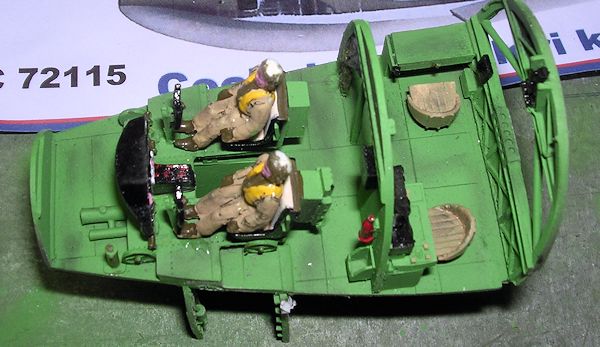 parts is not too
far from what it should be though more attention should have been given to this
area than I did which in my view it was going to be black underside and all the
extra work will not merit as it is not appreciably visible. Looking hindsight I
should redo this area, which is not too much a hassle. The upper turret was
deleted and the area blanked with a piece of plastic card and faired with a
little filler before smoothening it.
parts is not too
far from what it should be though more attention should have been given to this
area than I did which in my view it was going to be black underside and all the
extra work will not merit as it is not appreciably visible. Looking hindsight I
should redo this area, which is not too much a hassle. The upper turret was
deleted and the area blanked with a piece of plastic card and faired with a
little filler before smoothening it.
The rear part of beaching gear had detail missing which I then added
after referring to Warpaint book No 25 that is dedicated to the Sunderland.
Other detail on the kit was the repositioning of the antenna mast and
added a loop aerial on the upper of forward fuselage. Three portholes were also
drilled and shaped to the roof and another one to the rear underside. These were
same size as the fuselage side portholes.
The engine cowlings suited the kit very well and the only modification
was required to the wing, which had the engine exhaust at the side of cowling
and the outlet at the leading edge area near the inner port engine area. Radial
engines were picked from spares box and made to fit inside the resin cowlings
from set U72-142.
Butt jointed
propeller blades formed the four sets of three blade props for the Mk1
Sunderland. These came with set U72-143. Rigging for the wing floats was made
from 0.3mm nylon fishing line.
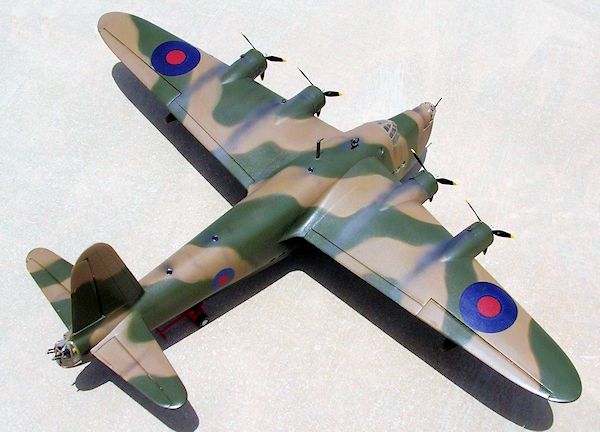 Being one of the very early versions of the Sunderland Mk1 I went for the dark
earth and green camouflage upper and black all undersides. Decals came from ESCI
set to represent N9046 during the early stages of the war. This flying boat was
damaged beyond repair at Sullom Voe in December 1940,
an
inlet between North Mainland and Northmavine on Shetland in Scotland. Today this
place is an important oil terminal.
Being one of the very early versions of the Sunderland Mk1 I went for the dark
earth and green camouflage upper and black all undersides. Decals came from ESCI
set to represent N9046 during the early stages of the war. This flying boat was
damaged beyond repair at Sullom Voe in December 1940,
an
inlet between North Mainland and Northmavine on Shetland in Scotland. Today this
place is an important oil terminal.
The
conversion was thought to be seemingly tough but it was not and I highly
recommend it to all those many modelers who have the Airfix Sunderland in their
stash and would like to make something different.
Carmel
J. Attard
May 2013
If you would like your product reviewed fairly and fairly quickly, please contact the editor
or see other details in the
Note to
Contributors.
Back to the Main Page
Back to the Review
Index Page



 throughout the war also while
protecting convoys on their way to Malta.
throughout the war also while
protecting convoys on their way to Malta.
 for 4 bombs that slide from inside the fuselage
under the wing root. Crew figures are included for the cockpit office, which is
sparsely represented, and for the three rotating turrets. Stage-by-stage
illustrated instructions make it an easy build in spite of its size. Decal sheet
for one camouflaged Sunderland Mk III in temperate maritime scheme is supplied.
for 4 bombs that slide from inside the fuselage
under the wing root. Crew figures are included for the cockpit office, which is
sparsely represented, and for the three rotating turrets. Stage-by-stage
illustrated instructions make it an easy build in spite of its size. Decal sheet
for one camouflaged Sunderland Mk III in temperate maritime scheme is supplied.
 parts is not too
far from what it should be though more attention should have been given to this
area than I did which in my view it was going to be black underside and all the
extra work will not merit as it is not appreciably visible. Looking hindsight I
should redo this area, which is not too much a hassle. The upper turret was
deleted and the area blanked with a piece of plastic card and faired with a
little filler before smoothening it.
parts is not too
far from what it should be though more attention should have been given to this
area than I did which in my view it was going to be black underside and all the
extra work will not merit as it is not appreciably visible. Looking hindsight I
should redo this area, which is not too much a hassle. The upper turret was
deleted and the area blanked with a piece of plastic card and faired with a
little filler before smoothening it. Being one of the very early versions of the Sunderland Mk1 I went for the dark
earth and green camouflage upper and black all undersides. Decals came from ESCI
set to represent N9046 during the early stages of the war. This flying boat was
damaged beyond repair at Sullom Voe in December 1940,
an
inlet between North Mainland and Northmavine on Shetland in Scotland. Today this
place is an important oil terminal.
Being one of the very early versions of the Sunderland Mk1 I went for the dark
earth and green camouflage upper and black all undersides. Decals came from ESCI
set to represent N9046 during the early stages of the war. This flying boat was
damaged beyond repair at Sullom Voe in December 1940,
an
inlet between North Mainland and Northmavine on Shetland in Scotland. Today this
place is an important oil terminal.